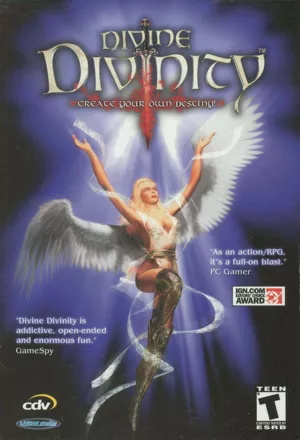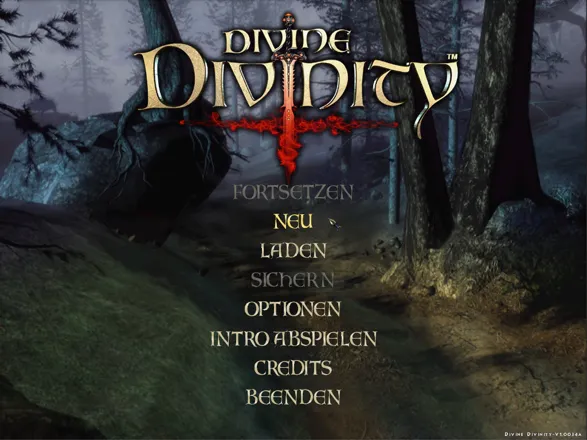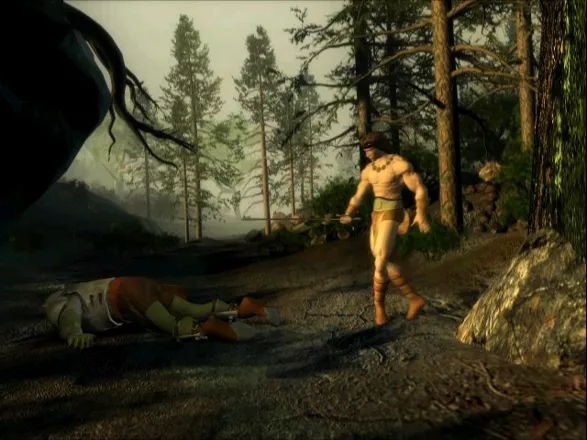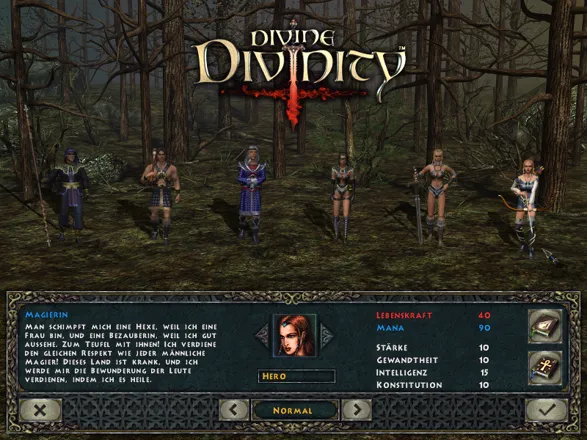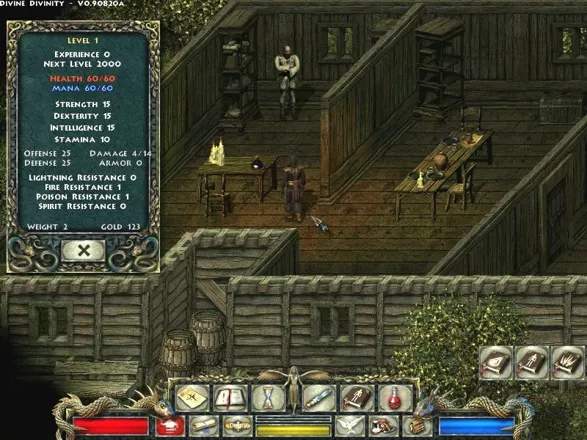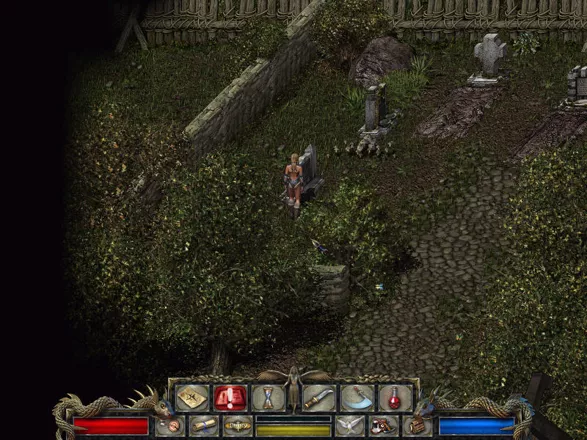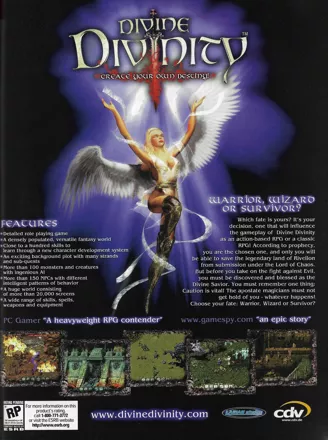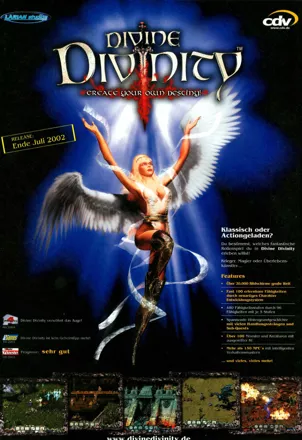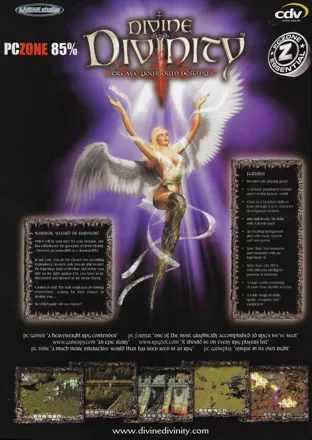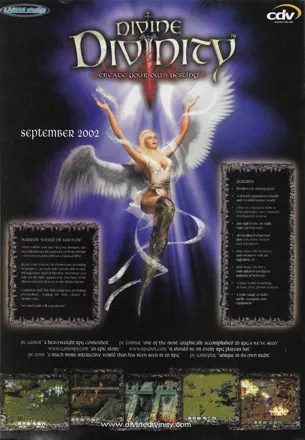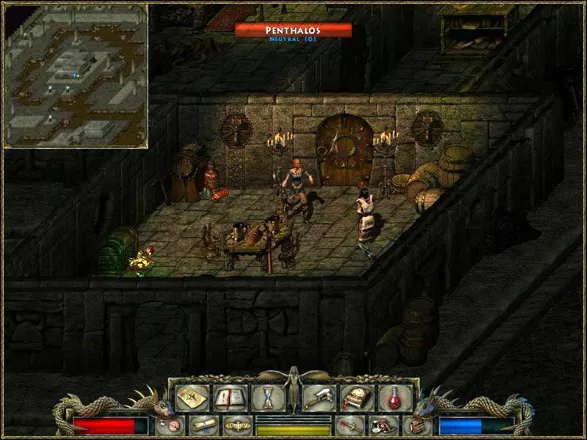Divine Divinity
Description official descriptions
Two thousand years ago, the wise mages of the Council of Seven sacrificed themselves to save the land of Rivellon. A Divine Order was established in their memory, sworn to protect the land from forces of evil. Now, growing unrest, corruption, and greed indicate that evil is near. The protagonist wakes up in a house in Aleroth, the town of healers, without any recollection of what happened beforehand. It appears that the leader of the healers has gone mad. The hero is asked to find a way to cure his predicament, which leads to a confrontation with higher powers, and eventually to a grand quest to unite the heirs of the Council and face the ultimate evil in battle.
Divine Divinity is a 2D action role-playing game with an oblique (rather than isometric) perspective, set in a fantasy universe. The game borrows certain elements from the Diablo series, most notably point-and-click action-oriented combat and item randomization. However, the game's locations are not randomized, and it contains many features of traditional role-playing games such as interaction with NPCs and multiple dialogue choices.
The entire game world consists of over twenty thousand screens, each one being a seamless transition into the next with weather effects as well as day and night cycles. The main quest progression is linear; however, there are plenty of sub-quests available, many with multiple solutions, and the main character is pretty much free to travel to most parts of the map right at the beginning. Also notable is the ability to loot almost anything, not just equipment or healing items, but also chairs, candle sticks, and pretty much anything that isn't nailed down (except tables).
In the beginning of the game, the player selects between three character classes for the protagonist, each coming in two variants (male or female): Warrior, Survivor, or Wizard. Each of these classes has four categories of unique skills. For example, the Wizard can specialize in elemental disciplines or choose the path of summoning various creatures, while Survivor skills include, among others, pickpocketing and alchemy. Each class can learn the skills of other classes, and the differences between them are mainly the starting skills and stat bonuses as they level up.
The game features a random item generator similar to, albeit less extensive than, Diablo. Items at certain locations have fixed names, but most attributes (like damage, armor rating, poison or stun effects, stat bonuses, or gem slots) are randomized. The player can also improve their weapons with gems dropped from enemies, or bought from shops; the dedicated player may even embark themselves on the quest to find the legendary weapons.
Spellings
- Divine Divinity. Рождение легенды - Russian spelling
- 神界 - Simplified Chinese spelling
Groups +
- Diablo variants
- Divinity series
- Fantasy creatures: Dwarves
- Fantasy creatures: Elves
- Fantasy creatures: Orcs
- Gameplay feature: Alchemy
- Gameplay feature: Auto-mapping
- Gameplay feature: Character development - Skill distribution
- Gameplay feature: Fog of war
- Gameplay feature: House ownership
- Middleware: Bink Video
- Protagonist: Female (option)
- Sound Engine: FMOD
Screenshots
Promos
Videos
Add Trailer or Gameplay Video +1 point
See any errors or missing info for this game?
You can submit a correction, contribute trivia, add to a game group, add a related site or alternate title.
Credits (Windows version)
285 People (254 developers, 31 thanks) · View all
| Agency |
|
| Special thanks to |
|
| [ full credits ] | |
Reviews
Critics
Average score: 80% (based on 45 ratings)
Players
Average score: 3.8 out of 5 (based on 68 ratings with 4 reviews)
The Good
This game came as a surprise to me. It has a silly name and an ugly box cover, yet I had to buy it and try it.. And it turned out to be quite a game. It's an isometric hack'n'slash fest, but with brains. Anyone who's ever played Diablo will recognize the style of fighting and anyone who's ever played an old Zelda game will recognize it's type of quests. The lands are huge, there are lots of things to see and do, plenty of people to talk to and an intriguing story behind it all. The fact that you get to shape your own weapons is a great idea and the overall equipment is equally satisfying both to the eye and for functoinality.
The Bad
The game could get a bit repetitive after a while and after fighting your thousand orc in the same way. The later parts of the game weren't near as good as the first parts either, maybe because it's a small company that made the game and they ran out of funds. Who knows.
The Bottom Line
If you liked the style of Diablo but want to give your brain a workout too (not only your trigger finger), then you really sohuld consider taking a look at Divine Divinity. It's a harmless little game filled with skills, quests and monsters. Thumbs up!
Windows · by Mattias Kreku (413) · 2003
Fun and addictive, if not terribly original.
The Good
Divine Divinity is, without a doubt, a Diablo II clone. The whole game system is totally based off of it. Diablo II had a great system, however, and that makes this game very enjoyable. The one thing it doesn’t share at all is the atmosphere-- in Divine Divinity, it's not dark and hopeless; the game has a much more friendly feel, almost uplifting compared to DII.
The game has three main classes, which, although they define your 'special ability' and your appearance (there are male and female versions of each class), do not lock you to their way. You can be a warrior with thief (survivor is the term used in the game... we all know the three classic archetypes) skills, or vice versa. The skill system is pretty interesting and open, and often you'll have three skills you want with only one skill point to put into them. That's a good thing-- nobody likes having half of their class skills be useless!
The game's visual appeal is very high. There are pool which reflect the area around them, adding a very 'lifelike' effect to the woodlands. The caves are dark, dank, slimy, and filled with pesky rats and other, more dangerous things. NPCs don't look too great, but they do okay.
The voice acting in the game is decent. It wasn't made by native English speakers, so it's actually pretty impressive, considering. It is still jarring to have someone say a sentence in the totally wrong tone of voice, however, and that often happens.
Music is a treat. The theme doesn’t wear on you at all... sometimes I fire up the game just to listen to it. In the game, you often you won't even realize how much the background music adds to the ambience.
The game interface takes a little while to get used to, but it's simple and easy once you take the five minutes to master it. Combat is quick, simple hack'n'slash, but this is not a game where the first opponents you meet are easy-- instead of hordes of easy enemies, you will meet a moderate amount of fairly challenging foes. Don't think you won't encounter hordes at any point in the game, though-- you certainly do!
The game has many other little spots that make it fun, too. You can buy a house and move furniture around to decorate it just right. The game is also funny at many points-- I really laughed at a few, which is rare in games-- which adds to the sense of life.
The Bad
Magic was actually a bit of a disappointment. Although the graphics are generally good, some of the magical effects are quite dull, and given that there aren't too horribly many of them, it's pretty bad having half your spells look odd.
The game seems to be easier for warriors than the other classes, but this isn't too much of an issue-- it poses a challenge to all the classes at many areas, and it only seems to be a little easier for swordswingers.
As mentioned above, the voice acting can be painful at a few spots.
The Bottom Line
Divine Divinity is a very enjoyable hack'n'slash game with some special features . It is surprisingly open-ended with many neat and sometimes funny side-quests; this keeps it quite enjoyable throughout all the main quest. Recommended.
Windows · by ShadowShrike (277) · 2003
The Good
Being very interested in game mechanics, I’ll start listing this game’s many good points with the huge amount of freedom you have in developing your character. Yes, there are three classes and your choice when you create your character does have certain effects, such as a wizard getting twice the amount of mana a warrior with the same intelligence would have or a warrior getting four times the damage bonus a wizard with the same strength would have, but you are completely free to raise those attributes however you wish and to pick any skills you think will better suit your playing style.
That’s right, all 96 skills are available to all three classes, so you can mix and match at will. Luckily, you will get a few skills for free over the course of the game and most mage skills can be learned from books, which can be found or bought, though the prices are steep. Even so, with each skill having five levels and the vast majority of the skills being useful, the 60 or so skill points you will obtain by the end of the game will need to be distributed carefully, making for several character development paths that could be just as good, depending on your playing style.
The game world is large and reasonably interesting as well. It will take a long time to explore every area, but you will likely find it worth your effort, as this game offers way more than swarms of enemies to kill and lots of nice loot to use or sell. Sure, there is a pretty insane amount of that as well, but there are also a whole lot of side-quests and even more NPCs that will have something to tell you, a fair portion of those discussions being quite humorous.
And the music is excellent as well, adding a lot to the atmosphere of every section of the game. (For those who are interested, it is available for download from composer Kirill Pokrovsky's site. Though it loses its meaning when separated from the game, seeing as it was made to perfectly accompany the various areas you will end up exploring.)
Another interesting thing that I need to mention is the kind of information your journal provides. Sure, it does the usual job of keeping track of quests, but statistics regarding the exact number of enemies killed of each type are also available, including some of the attributes of each, which can be nice if you simply want to keep score but can also provide some useful information that you could use in preparing for future fights. Also, you’ll be able to see some detailed information about your character on a screen that adds descriptions for each attribute, including your level and your resistances. And many of those descriptions will tend to be at least somewhat humorous, which to me says that the developers enjoyed making this game and wanted to provide the players with as many reasons as possible to enjoy playing it as well.
The Bad
Likely the main issue has to do with the combat system. As one would expect, it closely follows the Diablo recipe, as many other games did as well, meaning that most fights just require you to click a button countless times. And sometimes you need to click that button as fast as you possibly can, for example if you are using the lightning spell, which hits the enemy instantly, so any fraction of a second lost between clicks translates into less damage done and therefore a higher likelihood of the enemy managing to hit back. That, coupled with the relatively small number of quickslots compared to the number of available skills, tends to diminish the positive value of such a varied and open character development system.
Another significant problem is the fact that the attributes of items are determined randomly when you first pass your mouse over them, the game only sticking to a general overall value of the item in question, roughly represented by the color of its name. So you may well need to first learn the location of any important items and then save before passing your mouse over them, reloading if the attributes you see are not suited for your playing style.
It’s quite a tedious process, made worse by the fact that adding charms to items that have free slots is a permanent decision. That can cause quite a lot of frustration if you add your good charms to an item and a short while later find one that’s more useful for your particular playing style, even if perhaps its overall value would be lower, but also if you decide against adding any charms but fail to find a better item for a very long time, meaning that you struggled with weaker equipment for no reason.
I also need to make note of the size of the dungeons. The world itself is large and quite interesting, but the dungeons tend to get tedious after a while. And the real problem with that is that they’re absolutely huge, usually spanning several levels, each of those levels being large in itself. There are usually a few interesting moments in each, for example I still remember the skeleton who very bluntly hit on me, but for the most part you’re just running through seemingly endless catacombs, fighting wave after wave after wave of enemies…
And then you have the main story, which isn’t noticeably better than you’d expect from such games, being one you have likely heard hundreds of times before and will likely hear hundreds of times more in the future. Thankfully, the side-quests, NPCs and humor save a good part of the overall impression, but it would have been much better if the main story would have avoided at least a couple of clichés…
The Bottom Line
If memory serves, I played and finished this game at least two and a half years ago. Yet I still remember it quite fondly, perhaps even more so just because I actually played Diablo II shortly after it and that showed me just how much better Divine Divinity is in every aspect. It’s true that it takes the basic Diablo II recipe and builds upon it, but it adds a lot to that recipe and in doing so it does nearly everything right, while Diablo II did pretty much everything wrong. At least that’s my opinion, regardless of how many will be bothered by it.
Therefore, despite its flaws and the uninspired name, I certainly have to say that Divine Divinity is Diablo II done right. If item attributes wouldn’t have been randomized, or at least not randomized so much, it would have probably been about as good as a game of this type could possibly ever be, seeing as the other problems are more or less inherent to the genre.
Windows · by Cavalary (11635) · 2010
Discussion
| Subject | By | Date |
|---|---|---|
| From the Dev Diary | Cavalary (11635) | Dec 3, 2012 |
Trivia
Manuscripts
One of the in-game manuscripts depicts a dragon and a url encoded in some runic alphabet. Upon decoding, you get the address www.valaraukar.de, which links to graphics designer Marian Arnold's personal website.
Polymorph
The 'Polymorph' spell is designed to transform an opponent into a harmless creature, such as a frog or a rabbit. After the transformation, the player can easily kill the opponent. But try this: Polymorph a member of the Black Ring at the first encounter. For example, he/she is now a frog. Beat the frog and he/she will, as usual, escape. When Janus later summons his allies in a scripted scene, the polymorphed member will not appear in its normal form, but still as the frog, even when weeks have passed between those two encounters.
References
- On Janus's castle's roof, there's a skateboard, a ramp and fitting graffiti on the walls. Elven sight is required to see it, though.
- On the second level under the Warrior's Guild in the Dark Forest, there's an open slate in the west wing. The cursor doesn't change, but the player can go down. In the small room below, there is a Kaa Gent scroll. It's useless, but the name refers to AA Gent, a Belgian soccer team not far from the studio.
- In the Treasure Cave, there's a tombstone which reads: "The heart of all at Larian Studios go out to those who died or were bereft in such tragic circumstances in New York, Washington D.C. and Pennsylvania, on September 11th, 2001."
- Many early forum regulars found their nicknames included in the game.
- In Imp World, behind a flower patch, there's a note which reads: "Bronthion was here".
- The game contains a short sword called "Sting". It glows near orcs and dragons, an obvious reference to Lord of the Rings.
- The game has a magic carpet. To make it fly, the player has to read the tag. It reads "Axeminster", the name of a carpet manufacturer in the United Kingdom.
- In the Farmlands, there a scroll with a poem tribute to Stephen King's IT: "Your hair is winter fire, Aventuris embers, My heart dwells there too. - Written by IT."
Information also contributed by Xoleras
Analytics
Related Sites +
-
Divine Divinity
Official Website -
Divine Divinity
CDV's Official Website for the game -
Divine Divinity @ Gamebanshee
News, walkthrough and various guides. -
Divine Divinity Patches
Locus Inn site describes what the various patches contain and offers them for download. -
Kirill Pokrovsky's Site
Music composer's site, offering the game's soundtrack as a free download. -
Kiya's Divine Divinity
The entire game and all its quests told through lots of screenshots. -
Quest Guide on Locus Inn
Available for download here are 2 files. One covers all the quests with the exception of the unique items quest, which are included in the second document. -
divinedivinity.net
Fan Site with maps and the rune alphabet
Identifiers +
Contribute
Are you familiar with this game? Help document and preserve this entry in video game history! If your contribution is approved, you will earn points and be credited as a contributor.
Contributors to this Entry
Game added by kbmb.
Macintosh added by Cavalary.
Additional contributors: MAT, Rebound Boy, Unicorn Lynx, Indra was here, Jeanne, Sciere, Kabushi, Klaster_1, Patrick Bregger, Cavalary, Plok, Danfer.
Game added January 5, 2003. Last modified February 20, 2025.


